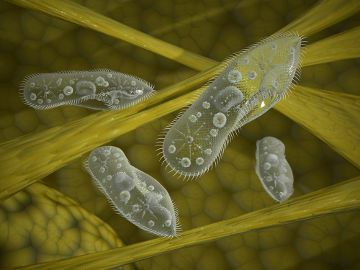Of mesodermal origin, the connective tissue is characterized by filling the intercellular spaces of the body and the important interphase between the other tissues, giving them support and set.
Morphologically, it has a large amount of extracellular material (matrix), consisting of a non-structural part, called structural amorphous substance (SFA), and another fibrous portion.
Amorphous Substance: formed mainly by water, polysaccharides and proteins. It can have a rigid consistency, as, for example, in bone tissue; and more liquid, as is the case with blood plasma.
Fibers: of protein nature, they are distributed according to the tissue, highlighting:
collagen → most frequent connective tissue fibers, formed by high-strength collagen protein (whitish color);
elastic → fibers formed primarily by the protein elastin, having considerable elasticity (yellowish color);
Reticulars → fibers with reduced thickness, formed by the protein called reticulin, analogous to collagen.
Therefore, in addition to the function of filling the spaces between the organs and maintaining it, all the diversity of connective tissue in an organism plays an important role in defense and nutrition.
The main types in vertebrates can be subdivided into two groups, based on a classification considering the composition of their cells and the relative volume between the elements of the extracellular matrix: connective tissue itself (the loose and the dense), and the special connective tissues (the adipose, the cartilaginous, the bone and the blood).
loose connective tissue
It is characterized by the abundant presence of intercellular substances and a relative amount of loosely distributed fibers. In this tissue, all typical connective tissue cells are present: the fibroblasts active in the protein synthesis, macrophages with high phagocytic activity and plasma cells in the production of antibodies.
dense connective tissue
Called fibrous connective tissue, it has a large amount of collagen fibers, forming bundles with high tensile strength and little elasticity. It is typically found in two situations: forming tendons, mediating the connection between muscles and bones; and in the ligaments, joining the bones together.
Do not stop now... There's more after the advertising ;)
The organization of collagen fibers in this class of tissue makes it possible to distinguish it into: non-shaped, when the fibers are diffusely distributed (scattered); and modeled, if ordered.
Blood Connective Tissue (Reticular)
This tissue has the function of producing the typical blood and lymph cells. There are two variations: myeloid hematopoietic tissue and lymphoid hematopoietic tissue.
Myeloid: Found in the red bone marrow, present inside the medullary canal of cancellous bones, responsible for the production of red blood cells (RBCs), certain types of white blood cells and platelets.
Lymphoid: It is found in isolation in structures such as lymph nodes, spleen, thymus and tonsils; it has the role of producing certain types of white blood cells (monocytes and lymphocytes).
adipose connective tissue
The adipose connective tissue is rich in cells that store lipids, with an essential function of energy reserve. In birds and mammals (homeothermic animals), it helps in thermal regulation (insulating), being distributed under the skin that constitutes the hypodermis.
Cartilaginous Connective Tissue
Cartilaginous tissue, devoid of blood vessels and nerves, is formed by cells called chondroblasts and chondrocytes. The chondroblast synthesizes a large amount of protein fibers, and with a gradual reduction in its metabolic activity, it is called a chondrocyte.
Bone Connective Tissue
Much more resistant than cartilaginous tissue, bone tissue is made up of a rigid matrix, formed basically by collagen fibers and calcium salts and various types of cells: osteoblasts, osteocytes and osteoclasts.
Osteoblasts are young bone cells, existing in regions where bone tissue is in the process of formation, giving rise to osteocytes that store calcium. Osteoclasts, in turn, are giant cells that promote the destruction of bone matrix.
By Krukemberghe Fonseca
Graduated in Biology

